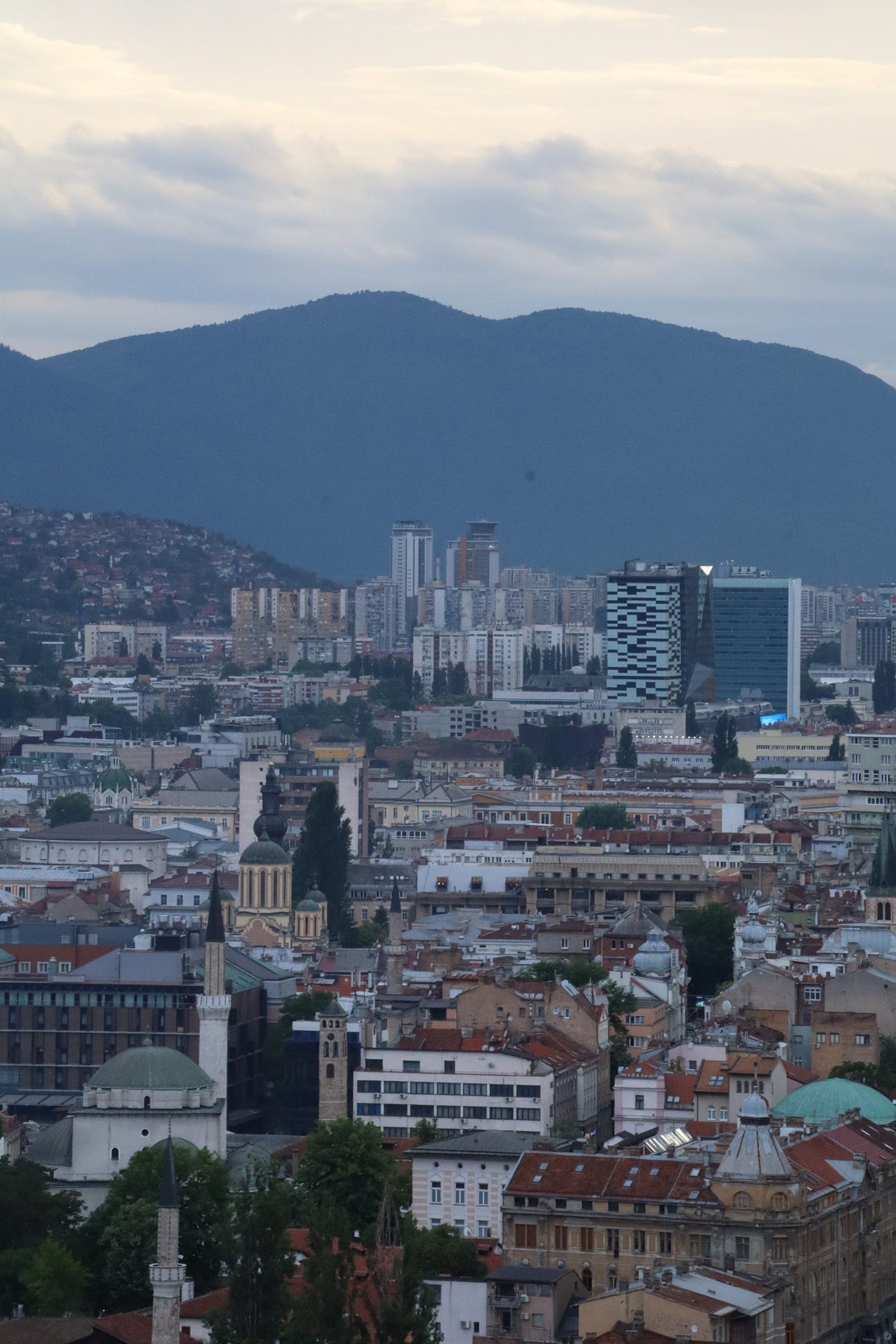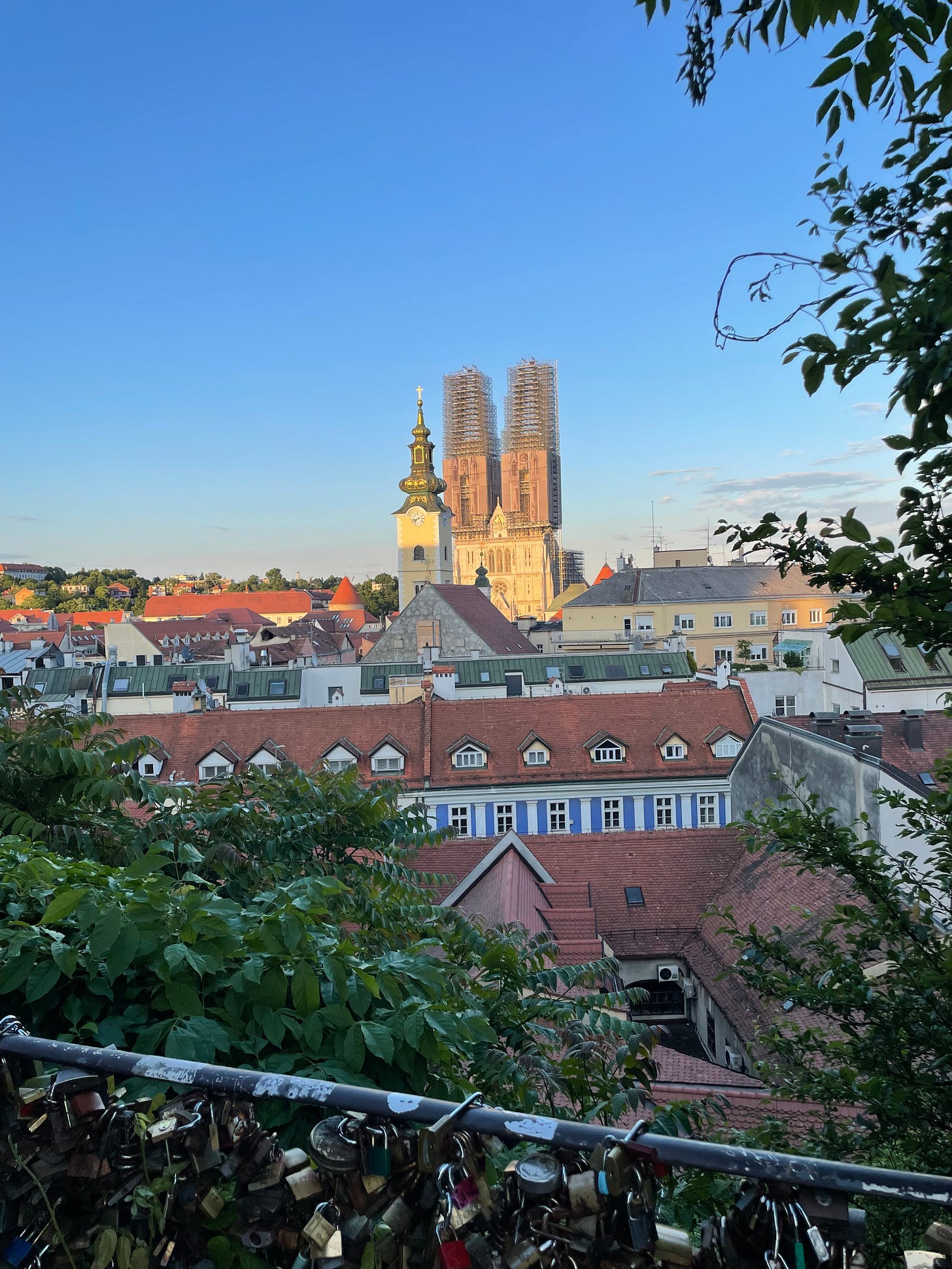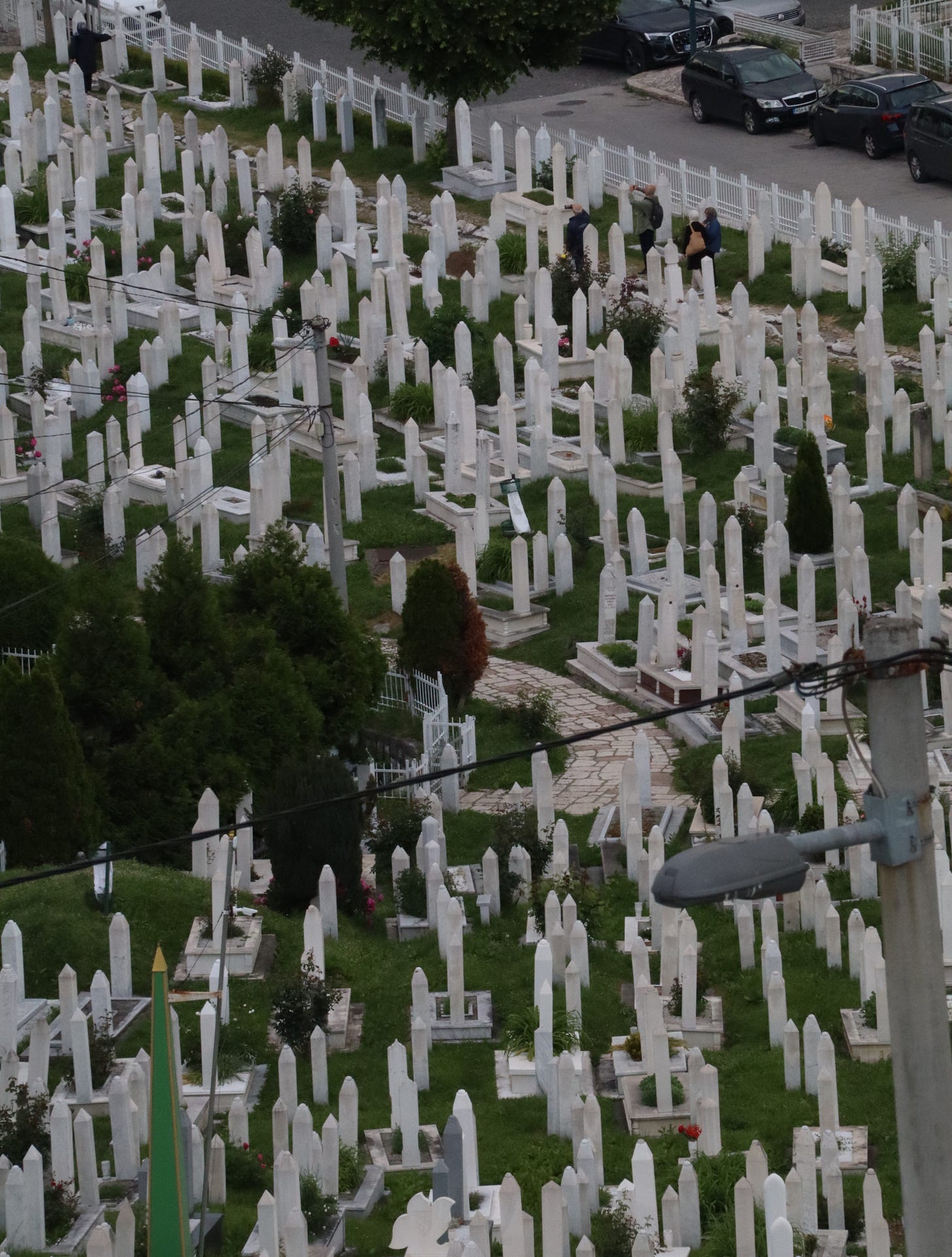Croatia, Bosnia and Herzegovina | all that we cannot see
Witnessing blindness: of the eyes, of nations, and of time
A Peaceful Start
I boarded the train to Zagreb feeling relaxed. After all, I had spent a good chunk of my week in Lake Bled, a peaceful Slovenian town in the Julian Alps. My days were spent running, hiking, reading, cooking, and sleeping.
I guess you could call it a vacation from my new occupation, visiting Old Towns!
The journey to Zagreb was supposed to be uneventful. It was a calm Saturday afternoon and, despite the first train being some minutes delayed, the next train was waiting for it to arrive so that it could depart.
I boarded the train car and found a cabin almost empty. There was another person in there and five seats were available. Perfect, I thought. Nice and relaxing three-and-a-half hour ride to Zagreb. I’ll read a book, call family, and enjoy the view until I hit the Croatian capital.
And so it went… until we got to Ljubljana, less than one hour into it.
The Chaos in Ljubljana
Ljubljana is the Slovenian capital. I considered spending some time in it, but it would be more of the same. I don’t need to see another clock tower, so decided not to. I thought Sarajevo was more historically appealing (more on that later), so I had to exclude a few stops from my route.
It turned out, however, that Ljubljana is a particularly popular spot. Sure, it is not London or Paris, but let’s just say it was more than our not-so-big train could handle.
Soon, people stormed into the wagons, filling up every cabin.
Chaos.
Not a “screaming fire in a movie theater” chaos, but, you know, people were hurrying to find an open spot, pushing through each other, grabbing bags, and trying to make them fit above their seats while defying laws of physics.
Soon, a couple sat next to me and we still had two open seats. Then, I heard a flustered conversation between two middle-aged women. I could sense concern and urgency despite not understanding a word of what was said.
While one tried to store their bags, the other pulled an old lady in and made her sit, right in front of me.
Blindness
I immediately realized that their mom was blind.
At first, I thought to myself “I won’t look, it’s not polite.” But after a few minutes, I remembered she was blind, so after all she couldn’t see whether I was looking at her. So, I started paying attention to her with a bit of curiosity.
It struck me how debilitating blindness is. I’m perhaps stating the obvious, but we don’t muse about this often. In our rushed lives, we don’t run into blind folks every day, so I took the chance to reflect on what a life being blind would be like.
Not great.
Before delving into this topic, it is important to note that there are many reasons someone would become blind. None of them as suggested by Saramago’s Blindness, of course.
You could be born blind. In this case, that’s life as you know. By the time you’re an adult, I imagine you are well used to this, and your other senses are very well trained. On top, it is very possible you attended specialized education, so you took all the possible mitigating steps.
There are also events or accidents that could cause someone to go blind. A striking example I read recently, in a book discussing the legacy of Genghis Khan, is that the Mongols instead of taking the captured soldiers as prisoners or integrating them into their society, which was often the case in their expansionist strategy, blinded 999 out of the 1,000-men opposing force. One of them was blinded in only one eye so that he could lead them on the way back.
Others will become blind later in life, due to natural causes, such as glaucoma and cataract. It is interesting to note, however, that if you live in a post-industrial society, these are very preventable given that you have, let’s say, health insurance, or a comfortable income.
Now, of course, I don’t know the life story of that lady.
It could be any of the options above. Or maybe she wasn’t fortunate enough to be able to afford the proper care to avoid blindness. Perhaps even, her condition was something with no cure. I’m not an ophthalmologist and I will not speculate on that.
But I wondered about her life as I watched her during that ride. She and the two daughters only stayed on the train for approximately one hour, but during this time I was reading a book, and the people next to me were using their phones or looking out of the view.
We sought distractions.
The old lady couldn’t, sadly. The whole time she was fidgeting her fingers, with nothing but her thoughts.
I hope her blindness didn’t come from a position where she could have acted.
Just imagine that!
It is probably the worst feeling in the world. Trapped in your thoughts, wondering how you got yourself in a vulnerable situation, depending on others for everything, and perhaps wondering what you could have done differently.
At least she had her children next to her.
I pity those in such situations but instead with estranged children, living far away, and with no one to talk to or get help from, just dealing with the consequences of the actions taken over many years, not seeing the warning signs or hearing the desperate pleas.
Ending up with nothing. No company and no courage to go to therapy. Instead, developing an alcoholism problem to forget about the self-inflicted issues, but with a story to tell, for sure.
I wouldn’t wish this on my worst enemy, let alone a loved one.
Once you’re blind, as far as I know, there is no way back. I’d do everything in my power to not let this be my fate.
They hopped off the train at a station in rural Slovenia. Given her age and the history of the country, rising from the socialist regime in the 90s and separating from Yugoslavia, it is possible that she just didn’t fall into the bucket of “living in a wealthy country (or neighborhood) where such diseases are highly avoidable.”
Unlucky, I guess, but probably better for the mind.
A Quiet Zagreb
My time in Zagreb was remarkably unexciting. I enjoyed it because I could run, work out, and stroll through the city. I did find it charming, but it is a skippable destination if you’re in the area. The weather wasn’t great, which is why I didn’t go to Split, Hvar, or Dubrovnik. Rain and beach just don’t go well together.
Sarajevo: History Layered on History
From there, I went to Sarajevo, the capital of Bosnia and Herzegovina (BiH). It was a trek to get there, as their rail network is not connected to other countries.
It was very much worth it, nonetheless, and I dare say one of the highlights of the trip so far. One of those places I just regret not having more time to spend there.
Sarajevo (and BiH, for that matter) has a very complex and intricate history. More history than they can handle, in a way. You probably have heard of it from your history class back in high school.
The Assassination that Sparked a War
Archduke Franz Ferdinand was assassinated on the corner of a street in the city center, giving the pretext for the Austro-Hungarian empire to declare war against the Serbian Army, which trained and supported the “Black Hand”, a secret military alliance that sought to destabilize the Southern Slav provinces and separate them from the Austro-Hungarian Empire.
I believe it is important to make this distinction. It was a pretext, not a cause for WWI.
There was tension mounting and rising nationalism in Europe. It was rather an excuse for it.
The Siege of Sarajevo
You may also have heard of Sarajevo from the Bosnian war in the 1990s. Bosnians, however, don’t like this term. They rather prefer calling it the “Siege of Sarajevo.” After visiting, I learned why the distinction is important.
The city of Sarajevo, of Bosniak majority (yes, Bosniak, not Bosnian) was surrounded by Serb forces. It was (again) a period of mounting political instability in the region.
The Berlin Wall had fallen in 1989 and the Soviet Union had collapsed haphazardly at the end of 1991. Yugoslavia, the last socialist force in Europe, was struggling, and separatist movements were bubbling up across the Balkans.
BiH had just become an independent state in 1992, but Yugoslavia did not take this well. Through lots of propaganda and military support, they sponsored the Serb ethnic group in BiH in their quest to take Sarajevo from the Bosniaks and ensure realignment with Belgrade.
Bosnia and Herzegovina: A Complex Mosaic
You might be confused. Let me explain. BiH has two regions. As you may have guessed, one region is called Bosnia and the other is called Herzegovina. Bosnia has a lot of mountains and more of a continental climate, while Herzegovina is closer to the sea and has a Mediterranean climate.
There are three ethnic groups: Bosniaks, Croats, and Serbs. Their respective languages are different, though mutually intelligible. These groups are, however, technically from the same ethnicity, with no way to phenotypically distinguish between them. Instead, these “ethnic” groups are more of a cultural type of segmentation.
Throughout its history, BiH was under Roman, Turk Ottoman, Austro-Hungarian, German, and Yugoslav rule. It is known as the “Jerusalem of Europe” and just by being there you can sense it.
In Old Town, a relatively small neighborhood, you have a true melting pot, and within a 5 to 10-minute walk, you can go to a mosque, synagogue, Catholic church, and Eastern Orthodox church.
Bosniaks, Croats, and Serbs are all Slavs. But they are Muslims, Catholics, and Eastern Orthodox. Sarajevo has a mix of all, but the Bosnia part of the country has more Bosniaks and Serbs, while Herzegovina is mostly Croats. Sadly, there are not many Jewish people left there, since most were deported to concentration camps by the German occupation during WWII.

A Geography Made for Siege
The Serb forces surrounded Sarajevo in April 1992. No one could leave or enter it.
Sarajevo means “valley of the palace”. The palace (“Saraj”) was made of wood and it burned long ago, with no remains left, but trust me, the valley is still there. Aside from a narrow strip in the middle of it, the city is built on the hills. Incredibly steep hills.
So steep that the Tour de France should have a stage there one day, going up and down all day to make it for entertaining television, and so steep that I did not feel any guilt when I ignored my watch suggestions to go on runs while there.
The geography made it the perfect trap. Serb snipers got situated at the top, shooting at anyone in their sight. Landmines were set up in the forest, making escape virtually impossible.
Later, the UN got control of the airport, and the Bosnian army built a narrow tunnel beneath the tarmac, which allowed many to escape to safety and humanitarian aid to be delivered.
Healing, Yet Still Haunted
Nonetheless, it was a dark time of terror. The first war in European territory since WWII. It was the longest siege of a city in modern history. It ended in February 1996, after the Dayton Agreement was signed in December 1995 and the Serb Army withdrew, ending the military stalemate.
The conflict also came out seemingly out of nowhere. In 1984, Sarajevo hosted the Winter Olympic Games. Eight years later, it was in a humanitarian crisis, which slowly crept in through propaganda that made neighbors turn against each other.
As you may recall from above, Bosniaks, Croats, and Serbs are all Slavs. The only way you can tell them apart is by checking their family name, which indicates their belonging to a given group.
While there, I saw a country healing. A mix of history preserved while modernizing. New edifices are being built, but you see houses falling apart next to them. Some to the point of no repair.
The Siege of Sarajevo scars are still left, and some show exposed wounds.
When I asked, out of an abundance of caution, whether it was safe to walk around, the answer I got was:
“Yes, it is safe in Sarajevo, but some houses are abandoned for a reason. Don’t go in there. Also, if you go for a hike, stay on the trail and don’t go where you can’t see the dirt. If the grass is high, don’t go there because there is a chance of a landmine still being there.”
Not that exploring abandoned houses is part of my travel style, but it makes you think that History is very much real and, in a way, still alive and destructive.
Forgiveness and Moving Forward
Sarajevo is a melting pot where people from different creeds coexist and, today, are blind to their differences, willing to forgive the past and build a shared future together.
I recommend it to everyone who seeks to understand the world we live in, eat good food, and see beautiful nature. While I didn’t get the chance to go there, I heard Mostar is also an amazing place to visit.
Or, in the words of a local I talked to:
“Don’t come to Sarajevo. Rent prices are high enough as is. We don’t want to be the next Barcelona.”
Upcoming Itinerary
📍May 26–27 — Belgrade, RS
📍May 28–31 — Skopje, MK / Tirana, AL
📍June 1–3 — Athens, GR
💬 Have you been to Croatia, Bosnia and Herzegovina, or elsewhere in the Balkans? I’d love to hear your thoughts, reflections, or travel tips!
Bio
Hi, I’m Guido, a Brazilian traveler who spent 13 years in the US before life nudged me toward a long-awaited dream: a year of exploring the world. I started this page to share my journey with family and friends, but if you’ve found your way here, I’m grateful you came along!





